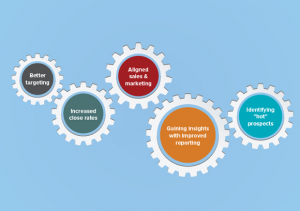The average click-through rates for display advertising are at a distressing value of 0.06%. These irritable advertisements have given a wide market to software like AdBlock which has made pay-per-click and on-site advertisement low-return marketing approaches. This created a dire need to adopt marketing automation services that use data driven strategies.
Data-driven marketing refers to the marketing strategy designed and developed after getting insights and consequential analysis performed from the data collected.
Data-driven marketing has enabled businesses to reach the right audience with the right products and services at the right time. Insights generated from data sets accumulated by the companies are manipulated and mined to get better leads and formulate accurate marketing strategies that increase ROI by 10% to 20%.
Key steps to design an effective data-driven marketing strategy
1. Prioritize professionalism and assemble your departments
Almost all the organizations have siloed departments with siloed data. You will have to make a single data corpus fed by all the departments such as sales, marketing, customer services, etc. Make this data corpus accessible from anywhere in the organization. This suggests forming a cross-departmental and cross-disciplinary team.
Choose or hire data scientists that are adept at handling data rather than picking random employees to do this job. You also need a team of data scientists with proficiency in working with all the departments, or one which is willing to learn the functioning of other departments.
If you are unable to get such individuals, hire a marketing automation consultancy or automated marketing service provider to help you with this.
2. Make your data accessible by efficient integration
Data is always in chunks and cluttered spreadsheets are resting uselessly in PCs when extracted by different departments. Mailing lists, purchase records, call center logs, sales people’s notes, customer’s feedback on different platforms, etc. need integration for developing an effective marketing strategy. This data is useless if its attributes can’t be related to analyze customer’s shopping patterns.
Merge each department’s data into a centralized data corpus and make it accessible from anywhere in the organization. Giving access to all the employees may create security concerns. Therefore, the decision of providing access lies with the C-suite. Generally, data scientists have access to the centralized corpus. They pass on the requested information to the department heads after performing suitable mining functions on raw data.
3. Set your ROI and KPI targets to know whether you hit the bull’s eye
Focus on key performance indicators of individual metric which could be anything, for instance, sales, traffic, product, etc. rather than targeting ROI. Gather appropriate data to design a marketing campaign that supports your targeted metric. Once your data-driven marketing strategy takes flight you will be able to track and measure responses to find which of your efforts made an impactful change in your business.
4. Scrutinize your customer’s behavior, expectations, and decision journey
Use data to scrutinize your audience to predict their current as well as lifetime value. Demographics, purchase history, website consumption, engagement on social platforms, etc. of your customers can be used as the criteria to design suitable marketing campaigns. Identify important turning points of your business such as click-away, abandonment, and conversion points that may help you understand what went wrong in the decision journey.
5. Test on a small scale and review
Before you invest all your resources in implementing a data-driven marketing approach, test it on a small scale. Run pilot campaigns to experiment new processes and discover new flaws. Treat your trial campaigns as your full-fledged campaigns. Analyze each test flight and compare the results with your predictions.
6. Time to roll out an extensive campaign
After receiving positive results for the conducted test cases, you are ready to execute a full-size data-driven marketing campaign. Deployment of this approach should be mapped with the pilot campaigns whenever relatable. Develop solid personas, and segment your data preemptively to make this work. Considering it as many short flights rather than a big one may help you deal with this approach with ease and confidence.
Benefits of adopting a data-driven marketing strategy
The most important benefit that businesses have gained through the deployment of a marketing automation strategy is to reach its correct audience. With the use of perfect analytics tools, data can create absolute magic. You can easily determine from where your business is receiving its maximum customers making it convenient to build the persona for your loyal customers.
According to Advance Ohio, here is how data has helped businesses to grow:
- 67% of the respondents confirmed that they can make more accurate decisions with the help of insights generated by data.
- With all the mined results in front of the company, this strategy helps in making decisions faster. 59% of the respondents agreed with this.
- Utilizing customer data has helped 39% of organizations to grow significantly.
- ⅔ of engaged data-driven marketers are attracting new customers due to their data-driven initiatives.
- ¾ of engaged data-driven marketers have witnessed increased customer engagement with implementation of strategies formed using data.
5 mistakes to avoid while creating a data-driven marketing program
1 – Don’t be rigid on an idea or strategy
When you deploy a data-driven marketing strategy, try to follow the leads generated by data rather than trying to fit the strategy into data. Make it a point to start with your data first, and then design a plan that could take you to your goal.
2 – Never ignore the possible consequences
Hurried decisions without thinking about the potential results could do more harm than good. Make sure you have thought in every possible dimension before the campaign goes live.
3 – Never believe that a strategy will work even if it has done wonders before
The reason behind implementing data-driven marketing ideas is to make an apt use of data and then form an actionable strategy. Using an old strategy in every scenario just because it worked well before may disrupt your business.
4 – Quit the belief system of “one true strategy”
Retrospect different entities such as time, place, targeted people, budgetary premises, past behavior, etc. before launching a strategy. A marketing campaign built on the basis of data insights will definitely be more engaging and get you better leads than believing in “one true strategy”.
5 – Don’t overlook data
The accumulated data clearly lists out your loyal customers, what their lifetime value could be, why some chose to leave you, etc. This could be a million dollar data if you know how to use it to transform or create a new customer base. Never ignore what your data suggests.
In all, data is the most crucial, yet inappropriately used component of digital marketing. Along with the necessity of a perfect marketing strategy, you also need up-to-date data sets for a successful marketing campaign. Cluttered, low-quality or inaccurate data can lead you to poor decisions which may impact your ROI negatively.
79% of companies have been using marketing automation for two or more years – Pardot.
Make this important shift to data-driven marketing approach in a hassle free manner with the help of our comprehensive white paper on the subject.









